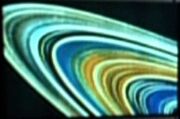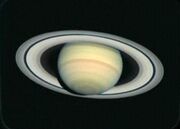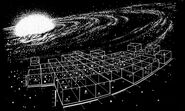Saturn (or Sol VI) was an uninhabited planet. The planet had many moons; three were named Mimas, Rhea, and Titan. The planet was located in the outer system. It was the sixth planet of the Sol planetary system. This system was located in Sector 001 (or Sol Sector), which was a region of space in the Alpha Quadrant. The planet was affiliated with the United Federation of Planets. (TOS: "The Changeling"; TNG: "The First Duty"; ENT: "Strange New World")
Saturnian Rings

Saturn's rings
Saturn was well-known for its rings. (TOS: "Charlie X";VOY: "Future's End, Part II"). An image of Saturn's rings, taken by the Voyager 2 probe in 1981, was displayed in astrometrics aboard the USS Voyager in the year 2374. (VOY: "Year of Hell", et al.) The rings of Saturn generated magnetic distortions. These distortions could make a starship invisible to another starship if the vessel could jump out of warp behind one of the planet's moons. (Star Trek)
History

Historical image of Saturn
In the mid-20th century, Saturn was depicted on the mission insignia for Apollo 17. On the insignia the sun god Apollo was looking toward Saturn. (ENT: "First Flight")
On September 1, 1979, the space probe Pioneer 11 became the first Human spacecraft to visit this planet. The probe made several important discoveries about this planet, such as that it had a magnetic field and a magnetosphere. (TNG: "Loud As A Whisper")
When she was a child, Rain Robinson was able to see Saturn's rings through her brother's telescope. She used to think that they looked like jewels from a pirate's treasure, All she ever wanted since then was to reach up and touch them. This was when she realized, she wanted to become an astronomer. (VOY: "Future's End, Part II")
In 1996, the Griffith Observatory featured an exhibit about Saturn. (VOY: "Future's End")
During the early 21st century the first manned Earth-Saturn probe was launched, under the command of NASA's Colonel Shaun Geoffrey Christopher. (TOS: "Tomorrow is Yesterday") Accompanying Christopher were astronauts Fontana and O'Herlihy. (ENT: "First Flight")
An image of Saturn was contained in the library computer aboard the USS Enterprise. This data was flashed on a viewscreen when the Talosians scanned the Enterprise computer in 2254. (TOS: "The Cage" remastered)
Saturn was featured in a nonsense-two-line poem that Charlie Evans forced Spock to recite in 2266: "Saturn rings around my head, down a road that's Martian red. (TOS: "Charlie X")
Saturn was seen on a map depicting the Sol system scanned by Nomad. (TOS: "The Changeling")
According to Arex, the cosmic cloud encountered by the USS Enterprise in 2269 had a diameter twice that of Jupiter, Saturn and Neptune combined. (TAS: "One of Our Planets Is Missing")
By the early 24th century a shuttle route had been established "from Jupiter to Saturn and back, once a day, every day," know as "the Jovian Run." Both Edward Jellico and Geordi La Forge used to pilot shuttles on this route early in their Starfleet careers. (TNG: "Chain of Command, Part II")
In early 2367 the invading Borg cube passed Saturn on its way towards Earth. (TNG: "The Best of Both Worlds, Part II")
In 2368, the Nova Squadron was set to perform a demonstration near Saturn that was be transmitted to that year's Starfleet Academy graduation ceremonies. (TNG: "The First Duty")
Teero Anaydis kept a photograph of Saturn in his home in 2377. (VOY: "Repression")
Template:SolSystem
Background Information
Saturn as seen from Rhea
Saturn was named after the titan (son of Uranus) from Roman mythology. It is unclear if Saturn itself was inhabited or not, though a reference made to Saturnius harem girls in TOS: "Mudd's Women" might suggest that it somehow is. The necessity of a daily shuttle run would also seem to support this possibility.
The Janus loop training program may be named after or related to Janus, another moon of Saturn.

The orbits of Saturn's satellites
A graphic of Saturn and the orbits of four of its moons was seen in TNG: "The First Duty" (depicted to the right). The outermost and largest moon was identified as Titan. The remaining three inner moons weren't named but it was very likely that they were Rhea, Dione, and Tethys, as they are the largest moons with smaller orbits than Titan (for instance, Iapetus was larger than both Tethys and Dione but its orbit was further away from Saturn than Titan's) and were all discovered in the 17th century and are well established.
According to Spaceflight Chronology, the Earth-Saturn probe mission was conducted on the UNSS Lewis and Clark. Signs of past mining activity was discovered from the second and fourth moons of Saturn, first proof of the existence of extraterrestrial intelligent life. This last detail and "One Small Step" would put the mission after 2032.
A painting seen in TNG: "Justice", according to Rick Sternbach, was meant to show Saturn as seen from its moon Rhea.
"The Explored Galaxy"
This chart was first seen, chronologically, in 2293. (Star Trek VI: The Undiscovered Country) This chart was also seen in several Star Trek: The Next Generation and Star Trek: Deep Space Nine episodes set in the 24th century, from the year 2364 to 2370. These were: TNG: "Conspiracy", "The Measure Of A Man", "The Emissary", "The Mind's Eye", "The Game" and DS9: "In the Hands of the Prophets", "Cardassians".
Star Trek: Star Charts
Saturn was classified as a J-class planet. This planet was a charter member of the United Federation of Planets in 2161. (Pgs. 39, "United Federation of Planets I")

